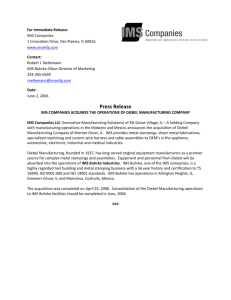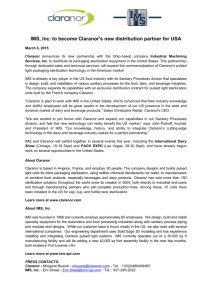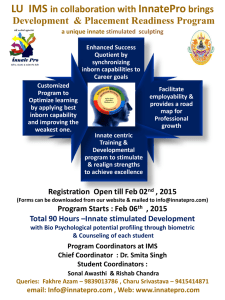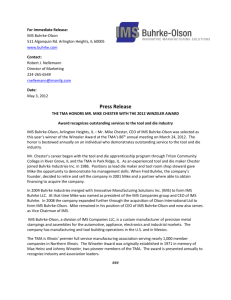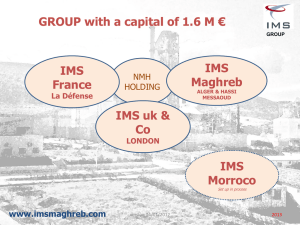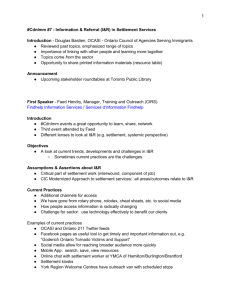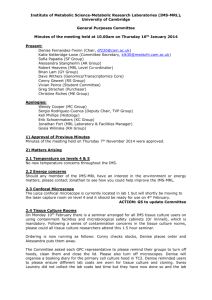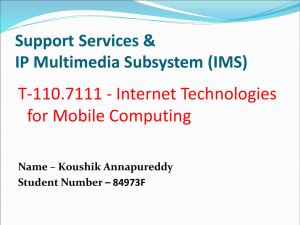What is Change? - Alliance of Information and Referral Systems
advertisement
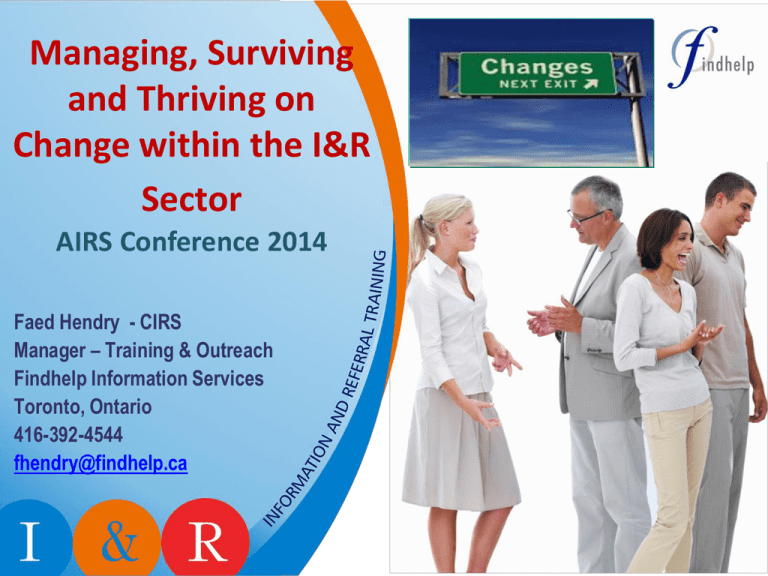
Managing, Surviving and Thriving on Change within the I&R Sector AIRS Conference 2014 Faed Hendry - CIRS Manager – Training & Outreach Findhelp Information Services Toronto, Ontario 416-392-4544 fhendry@findhelp.ca Session Objectives and Outcomes At the end of this session you will be able to: Identify your role in managing change within the I&R services sector. Describe the need for change, why many people fear uncertainty and how to overcome barriers. Identify emerging trends and issues in I&R that will require change management. Develop change management skills & harness enthusiasm to bring about successful change Exercise: Identify and Managing the Change • On the exercise sheet that you have been provided, please identify up to 3 significant changes to the field of I&R or your workplace that you have occurred since 2000 (or since you were hired.) • These should be fairly sizeable or significant changes. Examples could include new programs new governance models, organizational structure, technology or information management systems, new policies or procedures, funding changes, etc. Be as clear and concise as possible Did You Know Video …the top 10 in demand jobs in 2010 did not exist in 2004? …the first text message was sent in 1992. Today more text messages are sent and received everyday, exceeds the total population of the planet. …that 1 in 8 people that got married in North America last year met on line. …Facebook has just broken the 1 billion people account barrier Working in the Field of I&R We all have seen change to: Standards and Quality Indicators for Professional I&R Additional Programs Channels of Access Information Management Systems I&R Computer Based Testing and Training Funding Technology and Telephony Open Source/Open Referral In the Past 25 Years I&R has gone from this……. To This….. http:// To This…… What is Change? • To make the form, nature, content, future course, etc., of (something) different from what it is or from what it would be if left alone • Change is an alteration of an organization’s environment, structure, technology or people. • Change is and always has been an inevitable part of life, especially in our work settings. What is Organizational Change? It is generally considered to be an organization-wide change, as opposed to smaller changes such as adding a new person. It includes the management of changes to the: Business processes and technologies Job design and responsibilities Organizational culture Policies/Procedures Mission, Values and Strategic Plan Staff skill sets and knowledge base If you are looking for the pace of change to slow, you are going to be sorely disappointed because we would lose our competitive edge and fail to meet the changing access needs of our clients. Two Perspectives on Change Management • Organizational change management - “I need results.” “We need to do things more efficiently.” “We need greater accountability and transparency” • Individual change management – “What will this mean to me?” How will this impact me? “What if I can’t adjust to the new transformation?” • Internal and External Forces Change Forces in I&R External • • • • • Funding Demographic Characteristics Technological Advancements Client and market changes Social and political pressures Internal • • • • • New Program Development New Ways of Doing Business Organizational culture New Staff/Management Strategic Plan Common Reactions to Workplace Change Resistance - The most common and initial response is resistance. We resist because somehow we feel change is beyond our control. We are all creatures of habit, comfort and security. Change is resisted through the absence of effective communication When changes are made, many employees lack the broader context or knowledge base of why the change is being made What makes change so hard? Change can impact on many aspects of an organization: Structure Strategy Systems Shared values Skills Style Staff The McKinsey 7-S Framework Checklist Questions Structure -How do the various departments coordinate activities? How do I&R team members organize and align themselves? Where are the lines of communication? Explicit and implicit? Strategy - How do we intend to achieve our objectives? Systems - What are the main systems that run the organization? Where are the controls and how are they monitored/evaluated? Shared Values - What are the core values? How strong are they? What is the I&R team culture? Style - How participative is the management/leadership style? Staff – What specializations are represented within the team? Are there gaps in required competencies? Skills - What are the strongest skills represented within the team? How are skills monitored and assessed? Other Reasons Staff Resist Change • • • • • • • • Fear Not being consulted Poor communication Changes to routines Low trust Misunderstanding about the need for change Exhaustion/Saturation -‘Here we go again” Others? Debriefing the Icebreaking Exercise Many of you responded to the Icebreaking Exercise. The most common changes identified were as follows: Let’s Take a Moment to Take Stock Wow – that’s a lot of change! Take a moment to think of an example of organizational change that you have experienced. – Was it successful? Did it go smoothly? Why? – How would have you done it differently? – What were your feelings early on? Later on? – What did the people around you say about it? Changes that you may have Experienced • • • • • • • • • • • New Lines/New Projects Role out of 211 and ADRC’s Load Balancing New Standards for I&R New Accreditation Criteria Database Inclusion Criteria New Governance Structures Social Media/Access Channels New Style Guide Open Source/Open Referral Dara Dashboards • • • • • • • • • • • Partnership Development CIRS/CRS Computer Based Testing I&R Online Training Call Recording Telecommuting/Work from Home SQM Reporting New IMS System New Call Tracking Systems New XSD Data Transfer Standards Disaster Preparedness Technology and Telephony What I&R’s Can Change Technology/Channels of Access Mission, Vision, Values and Strategy Task-Job Design: The way work is performed in the I&R can be changed with new procedures and methods for performing work. Human-Behavioral Changes: Training can be provided to managers and employees to provide new knowledge and skills, or people can be replaced or downsized. Organizational Structure/Culture/Offerings Change is about Process but more importantly People • The fact is that organizations don't just change because of new systems, processes or new organization structures. They change because the people within the organization adapt and change too. • Only when the people within it have made their own personal transitions can an organization truly reap the benefits of change. • All sources of resistance to change need to be acknowledged and people's emotions validated Change from the I&R Management Perspective I&R Managers’ perspective on change is results oriented. Their primary concerns are: When can the change be completed? How much improvement will be realized? How will this change impact our financial performance? What is the required investment? How will this change impact our clients? ADKAR – 5 Elements for Individual Change Awareness of the need for change (why). Desire to support and participate in the change (our choice). Knowledge about how to change (the learning process). Ability to implement the change (turning knowledge into action). Reinforcement to sustain the change (celebrating success). An I&R Work Scenario Take for example the implementation of an Information Management System (IMS). If the change is implemented and you believe it was not needed (i.e., you were not aware that any changes were required), then your reaction might be: “This is a waste of time.” “Why change if it was working just fine before?” “If it ain't broke, don't fix it.” “They never tell us what’s going on” An I&R Work Scenario If someone had taken the time to explain that the old IMS would no longer be supported by the vendor, or that new IMS was necessary for improved service delivery, coordination and reporting, then your reaction (based on this awareness) would likely be very different: • “How soon will this happen?” • “How will this impact me?” • “Will I receive new training?” An I&R Work Scenario You have decided to implement call recording. You know that this will not be a popular decision with your front-line I&R staff. How would you communicate the message? What would you do to try and get buy-in? What will the end result be? Three Phases of Change Current State Transition State Future State Successful change in I&R addresses both the technical and the people side Solution is designed, developed and delivered effectively (Technical side) Project management Current Transition Change management + Future Solution is embraced, adopted and utilized effectively (People side) = CHANGE SUCCESS Individual PEOPLE change, NOT organizations Individual Change Management is the Centerpiece of Success The secret to successful change lies beyond the visible and busy activities that surround change. Successful change, at its core, is rooted in something much simpler: How to facilitate change with one person. From ADKAR: a model for change by Jeff Hiatt A D K A R I&R Trends/Issues That You Will Need to Manage Open Referral/Open Source Load Balancing New Technology and Telephony (Mobile Apps, Chat, IM) Telecommuting Practices Quality Assurance Practices (Call Recording, KPI’s) Discussion Boards Collaboration and Partnerships Disaster Preparedness/Emergency Management Faed’s 10 Tips for Embracing Change in I&R Respond to change, don’t react to it Recognize why change is needed Choose optimism over fear Use the “Balance of Rowing” Principle Be Patient Be willing to learn something new Keep the lines of communication open Increase your adaptability factor – be accepting of the now Change or Perish (Think MySpace) I&R is Change. Growth is Optional. Choose Wisely. “Everyone thinks of changing the world, but no one thinks of changing himself.” - Leo Tolstoy Thank you for participating! Faed Hendry Manager – Training and Outreach Findhelp Information Services 543 Richmond Street West Ste 125 Toronto, Ontario M5V 1Y6 416-392-4544 fhendry@findhelp.ca

